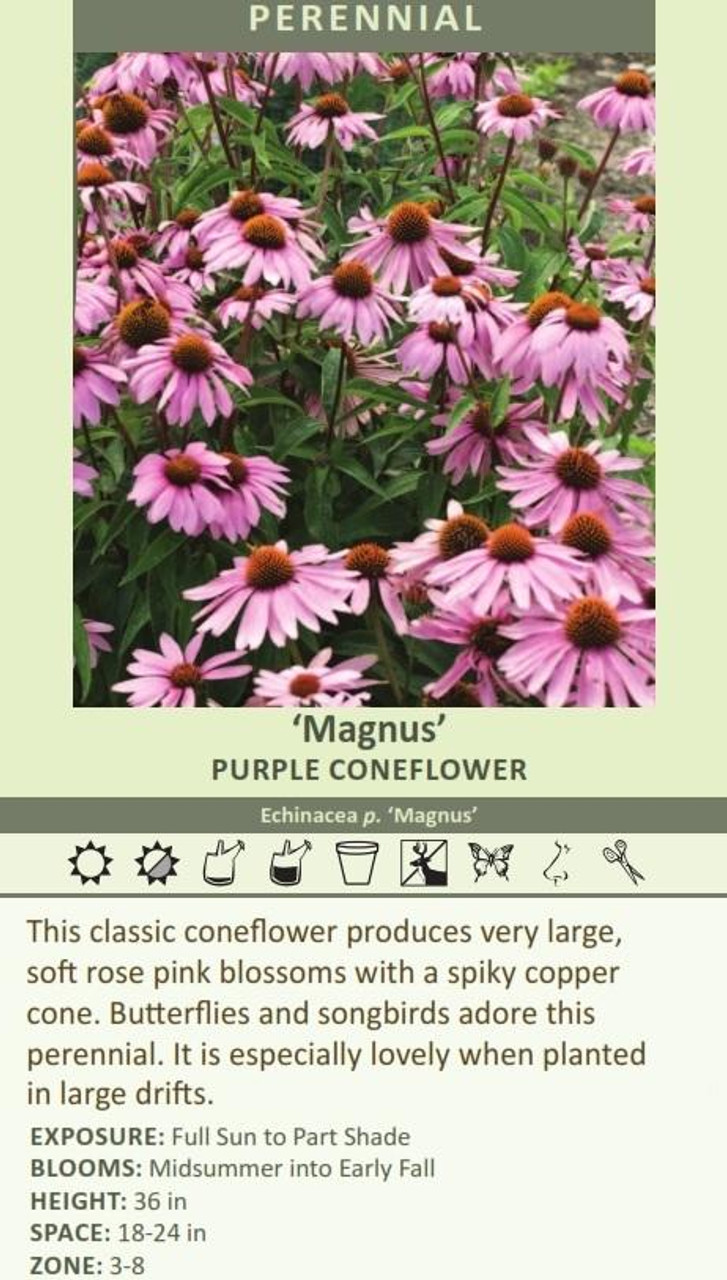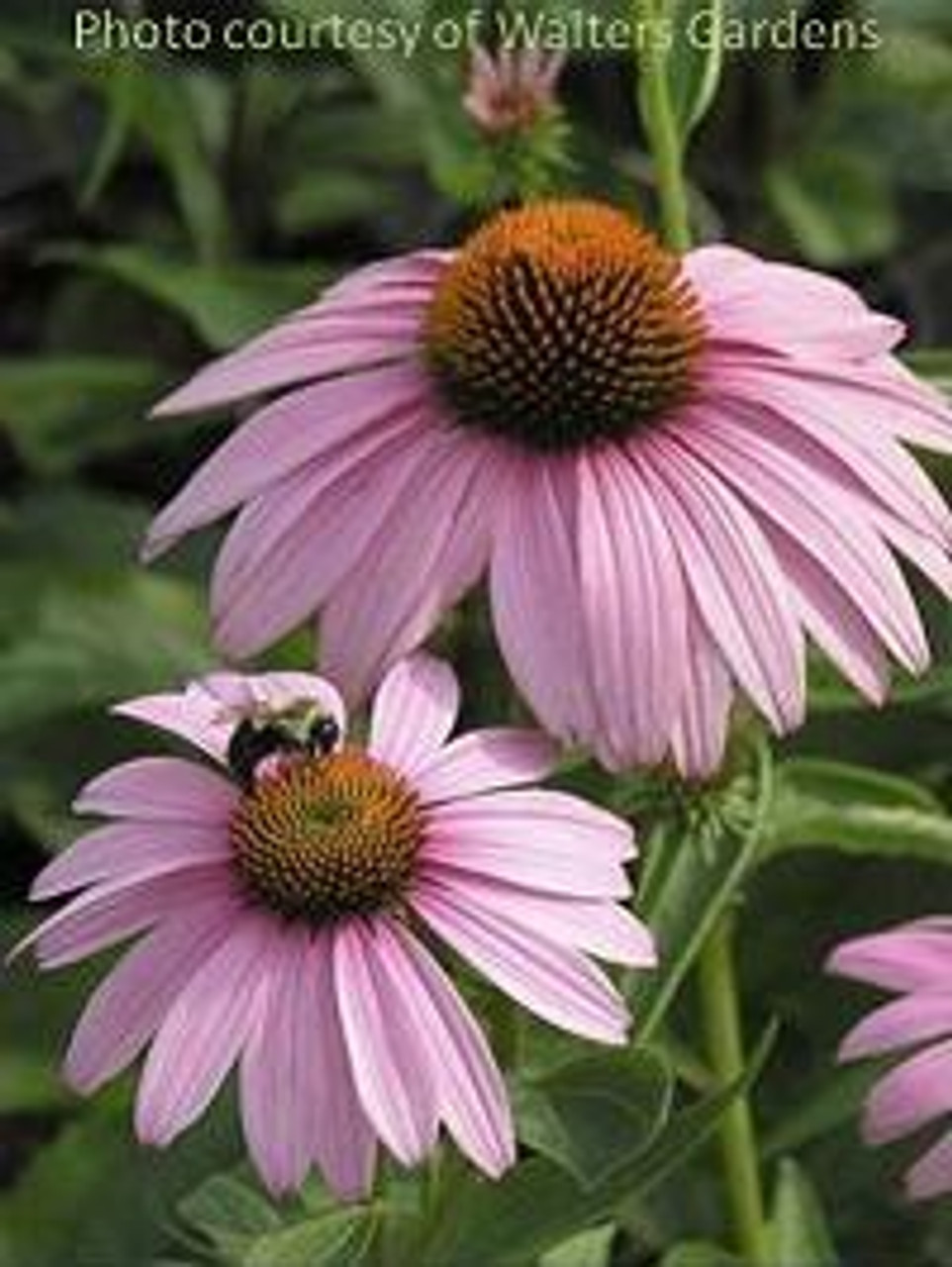Product Description
Echinacea p. 'Magnus' (4) 1-gallons
PURPLE CONEFLOWER
Zones 3 to 8.
Full sun to part shade.
- Clump-forming perennial may reach 3 feet tall and 2 feet wide.
- Daisy-like, 3-to-4-inch flower with a large, coppery-brown, spiky central cone, surrounded by 10 to 20 rose-pink ray florets. Bloom period begins mid-summer and lasts into fall.
- Best grown in organically rich, well-drained soils in full sun to part shade. Performs well in full sun in the north but prefers some afternoon shade in the south.
- Attracts butterflies and drought resistant. Excellent cut flower - let the blooms dry completely and scatter the seeds in the garden.
Echinacea purpurea 'Magnus' is a classic and highly popular coneflower cultivar that is prized for its large, vibrant pink flowers and sturdy, upright habit. It is a fantastic choice for adding a burst of color to gardens and attracting pollinators. Here is a closer look at what makes it special:
Appearance:
- Flowers: 'Magnus' produces large, daisy-like flowers with rosy-purple petals that radiate outward from a prominent central cone. The petals are held horizontally, creating a striking, flat-faced appearance. The flowers are typically 4-5 inches in diameter and bloom profusely from early summer to late summer.
- Foliage: The plant has strong, upright stems that typically do not require staking, even in windy conditions. The foliage is a deep green color and forms a clump that can reach 2.5 to 3 feet tall and 1 to 1.5 feet wide.
Growing Conditions:
- Light: Thrives in full sun to partial shade. For optimal flowering, it is best to provide at least 6 hours of direct sunlight per day. It can tolerate some shade, but flowering may be reduced.
- Soil: Prefers well-drained soil and is quite drought tolerant once established. It is adaptable to various soil types but performs best in moderately fertile soil.
- Hardiness Zones: Hardy in USDA zones 3-8, making it suitable for a wide range of climates.
Uses:
- Borders and Beds: Its upright habit and vibrant flowers make it a perfect addition to borders, beds, and cottage gardens.
- Cut Flowers: The flowers make excellent cut flowers for fresh or dried arrangements.
- Pollinator Gardens: It is a great choice for pollinator gardens, attracting bees, butterflies, and other pollinators with its abundant nectar and pollen.
- Naturalizing: 'Magnus' can also be used for naturalizing in meadows or wildflower gardens.
Additional Benefits:
- Long Blooming Season: 'Magnus' blooms for an extended period, providing continuous color throughout the summer.
- No Deadheading Required: It does not require deadheading to continue blooming, making it a low-maintenance choice.
- Drought Tolerant: Once established, it is quite drought tolerant, making it a good choice for water-wise gardens.
- Cold Hardy: It is cold hardy and can withstand harsh winter conditions.
Overall, Echinacea purpurea 'Magnus' is a classic and reliable coneflower cultivar that is prized for its large, vibrant flowers, sturdy habit, and adaptability. It is a fantastic choice for adding color and attracting pollinators to any garden.
(4) 1-gallon containers ready to plant, plants may be trimmed for shipping,
Other Details
The most important part of the plant is its root system. Healthy roots are the foundation of a healthy, vibrant plant. The type of plug container used is based on the specific needs of the plants. Perennials offered as bare root traditionally perform better when planted as bare root.Planted in a specialized mix, potted plants have well established root systems. Top growth stage will vary depending on the current life cycle and time of year when shipped. In Winter and early Spring dormant plants may be shipped. Dormant plants may be planted right away, even before the last frost date.
Most bare root varieties are field grown for at least one season, though Hemerocallis and Hosta are grown for two seasons. The bulk of the soil is removed during the harvesting process and the tops of most varieties are trimmed back to the crown. They are graded, packed in shredded aspen or sphagnum moss and stored in freezers until ready to be shipped.
See our Container Sizes and Bare Root Perennials pages for more information.
Plant information and care is provided in the Overview section, Plant Genus Page and general information is provided in the Planting Care & Guides. Additional questions can be asked on each Plant page.
Plant Spacing: Using the maximum mature spread or width of a plant to guide spacing, ensures space to grow to full size. To fill an area sooner, plant them closer together. Just remember, future thinning or transplanting may be needed.
Water: Keep a close eye on newly planted perennials, especially throughout the first growing year. Most early plant loss is due to too much or too little water!













